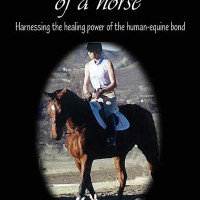Equine therapy is many things. Powerful. Innovative. Spiritual. However, there are also many things that equine therapy is not. Unfortunately, like any alternative treatment modality, work with horses has been subject to its share of misinterpretations. As these incorrect beliefs have surfaced, those who work in the field have had to answer many questions, in service of clarifying what equine therapy really is.
So, let’s talk about a few of the most prominent equine therapy myths.
- Equine therapy involves riding horses. Actually, all mental health treatment that includes horses is done on the ground. While the therapist or equine specialist may have the participants perform several exercises or challenges with horses, they are all done unmounted. For example, a client may be asked to lead a horse through a maze of obstacles, place a halter on a horse, groom a horse, or pick up a hoof. Typically, the therapist, equine specialist and client together will examine the ways in which the client approached the situation, the horse’s reaction, and extrapolate this meaning into other areas of the person’s life. Another approach, which is more naturalistic, is to simply allow the horse and the client to be in the same space, and examine the horse’s response, inferring meaning based on the horse’s natural herd tendencies. (i.e.: this is what the particular behavior means in the herd).
- Working with horses is dangerous. While horses are certainly large and fast moving animals, when done correctly, equine therapy is typically quite safe. In fact most every certification and training program in today examines safety as the first part of the therapeutic process. This safety includes not only the client’s physical safety, but also psychological feeling of safety.
- Equine therapy is only for developmentally disabled children. Originally established to help children suffering with physical disability regain the ability to walk again, equine therapy first gained prominence as a therapeutic riding modality. However, with the Horses for Heroes program, equine therapy for mental health issues is now quite well recognized. In fact, in terms of numbers, there are more Veterans who could be served by work with horses than children with developmental disabilities.
- Equine therapy lacks research credibility. With a research foundation established solely for equine therapy research (www.horsesandhumans.org), there are now several studies looking at the therapeutic benefits of work with horses. These studies have not only been published in several peer reviewed journals, but are now being conducted at many universities throughout the United States. Additionally, many of the certification and training organizations, such as the Professional Association of Therapeutic Horsemanship (www.pathintl.org) and the Equine Growth and Learning Association (www.eagala.org), publish past and current research on their website.
- Most mental health issues cannot be targeted with equine therapy. Equine therapy can actually be used to target almost any mental health issue. The diagnosis that may be excluded would be those that place the horse at harm, such as Conduct Disorder. However, horses have been incorporated into many eating disorder treatment centers, programs that work with ADHD children, therapists who specialize in trauma, and certainly there are many therapists utilizing equine therapy for mood disorders.
As equine therapy gains greater acceptance in the therapeutic community, in time those who are unfamiliar with horses will come to understand what horse lovers have known for years — that the outside of a horse is good for the inside of a man.
Best,
Claire Dorotik LMFT
